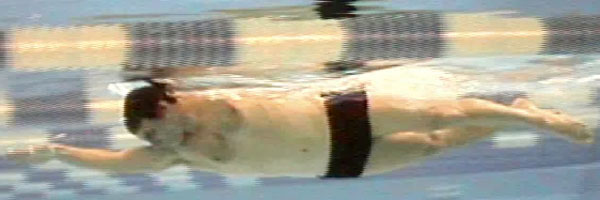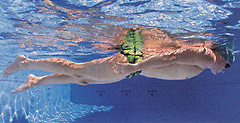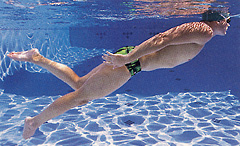|
|
Warum die Wasserlage so wichtig ist |
Why Body Position and Balance are Crucial |

|
|
Geradeaus schauen kann sich gut anfühlen, aber es hat zur Folge, dass deine Hüften und Beine absinken. Du hast eine schlechte Wasserlage und Mühe mit dem Beinschlag.

So bald du deinen Kopf senkst, und ihn in Verlängerung der Wirbelsäule hältst, kommt deine Hüfte hoch und der Beinschlag wird effektiver. Tip: Schau auf den Boden des Beckens und lehne mit der Brust ins Wasser. Du hast das Gefühl abwärts zu schwimmen! Was ist falsch daran nach vorne zu schauen? Viele Trainer und Schimmlehrer sagen, du sollst nach vorne schauen, das Wasser müsse auf Haaransatz- oder gar auf Augenbrauenhöhe liegen. Vielleicht hörtest Du auch "Kopf runter und ab die Post" für den Endspurt. Und jetzt heisst es, du müsstest Kopf und Brust tief halten. Diese widersprüchlichen Informationen sind verwirrend. E s geht um Folgendes: der Schlüssel zum effizienten Schwimmen liegt in der richtigen Wasserlage und Körperhaltung. Viele Schwimmerinnen und Schwimmer meinen Schwimmen sei vor allem harte Arbeit: "Ohne Fleiss kein Preis." Sie versuchen vor allem im Training müde zu werden. Der Hauptgrund aber, warum sie müde werden, ist inneffizientes Schwimmen. Sie könnten genau gleich schnell schwimmen mit weniger Aufwand. Als erstes müssen Kopf, Brust, Hüfte und Beine in einer Linie bleiben, insbesondere der Kopf und die Beine. Das reduziert den Widerstand um Dimensionen. Tiefe Kopf- und Schulterlage (s. Bild rechts) bringen die Hüfte und die Beine nach oben, sogar ohne Beinschlag. Du kannst das Pull-Buoy im Schrank versorgen - für immer. Wenn du skeptisch bist, versuchs doch mal. Schwimm eine Länge mit Blick ans andere Beckenende und die nächste mit Blick gerade nach unten. Das Wasser darf ruhig mal über den Hinterkopf fliessen. Natürlich braucht es ein bisschen Übung - alte Fehler sterben langsam - aber vielleicht fühlst du dich besser beim Rollen und Ziehen als je. Ausserdem sind deine Nackenmuskeln wesentlich entspannter als wenn du immer deinen Kopf hochhalten musst. Für die technisch Interessierten: Eine flache Wasserlage und ein gestreckter Körper [Körperhaltung und Schweben] [Lerne zu Schweben] reduzieren den Wasserwiderstand wie gesagt sehr stark. Der Wasserwiderstand wächst nämlich mit der Geschwindigkeit im Quadrat, und die erforderliche Leistung im Kubik. Das heisst, wenn du doppelt so schnell schwimmen willst, musst du 8mal soviel leisten. Dann ist es doch logisch, dass die Suche nach einem Weg, den Wasserwiderstand zu senken mehr nützt als die schwimmerische Leistungsfähigkeit zu erhöhen. |
Looking ahead may feel right, but see how it drives your hips and legs down, making it harder to balance and kick.

As soon as you drop your head in line with your spine, your hips come up and your kick is more effective. Hint: Look at the bottom of the pool and lean with your chest in the water. You have the feeling of swimming downhill! What's wrong with looking ahead? Many coaches and instructors told you to look ahead while swimming freestyle and keep the water at your hairline or even your eyebrows. Maybe you've also heard coaches say, "Put your head down and go for it," in the last stretch of a race. And now it is said to keep your head and chest always down. With all that conflicting information, it's no wonder you're confused. Here, then, is some clarity. The key element of efficient swimming is balance and body position. Dropping your head to its natural position–in line with your spine–immediately pops your hips to the surface and makes your kick more efficient. Many swimmers think swimming is hard work: No pain no gain. They concentrate on getting tired. But the reason they're killing themselves is because they can't swim efficiently. They could swim as fast with less effort. First of all, keep head, hips, and legs in line. This reduces drag by dimensions. Keeping your head and shoulders down (s. image to the right) allows you to keep your legs up without kicking. It's also natural and effortless–the way you are on dry land. If you're looking down, you can press your chest into the water, which is how your whole body is supported as you swim. You don't need your pullbuoy any more. If you're still skeptical, try it for yourself. Swim one lap looking at the wall you're heading toward and a second lap with the top of your head aimed at it instead. It may take a little practice–old habits die hard–but you'll probably find yourself rolling and stroking more easily than you ever have. You'll also relax the muscles in your neck that used to hold your head up. For the technically oriented: Swimming flat on the water surface and producing as little resistance as possible [Posture and Floating] [Learn how to float] reduces drag enormously. Drag in the water increases with velocity to the power of two and the power needed with the power to the three! This means if you want to double swimming speed you need 8-fold as much power. Logically enough, working on reducing drag is more efficient than increasing swimming power!! |
|
|
|